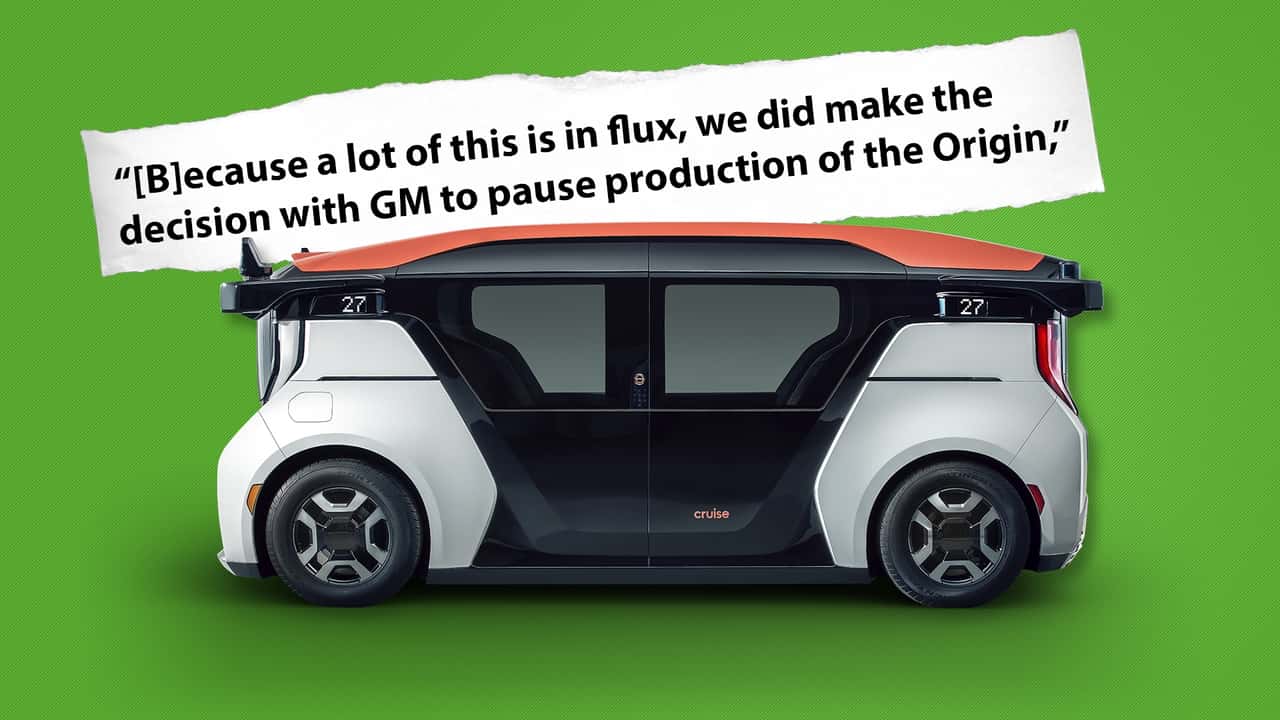General Motors’ autonomous ridesharing division, Cruise, has faced a series of setbacks in recent weeks. The company’s permit to offer driverless rides in California was suspended due to safety concerns, and now Cruise CEO Kyle Vogt has reportedly confirmed a pause in production of the electric Cruise Origin people mover. This comes as another blow to the struggling robotaxi company.
During an all-hands meeting, Vogt acknowledged the production pause and discussed how the company would handle the suspension of its driverless operating permit. The permit was suspended after a woman was critically injured by a human-driven car and then hit by a Cruise-branded driverless Chevrolet Bolt EV. State regulators accuse Cruise of misrepresenting the safety technology of its driverless cars and have expressed concerns about pedestrian safety.
The Cruise Origin is a purpose-built, fully-electric Mobility as a Service vehicle developed by Cruise, General Motors, and Honda. It was meant to have a completely driverless cabin with ample space for passengers. However, most Cruise vehicles currently in operation are Chevy Bolt EVs. Cruise had plans to eventually use the Origin for both ride-hailing and deliveries.
Production of the Origin was taking place at GM’s Factory Zero factory in Michigan. It is unclear how the pause in production will impact workers at the plant. Vogt mentioned that hundreds of Origin vehicles have already been built, which should be sufficient for the near future.
A GM spokesperson confirmed the production pause and expressed belief in the transformative potential of autonomous vehicles. The spokesperson stated that the Origin is an important part of Cruise’s autonomous vehicle journey and will make transportation more accessible.
Cruise has been facing financial challenges throughout its history, with losses amounting to $1.9 billion in 2023 alone. With the suspension of driverless operations and a high worker-to-robotaxi ratio, the company may need to rely on its cash reserves to stay afloat. However, GM CEO Mary Barra remains optimistic about Cruise’s growth and expansion opportunities.
Overall, Cruise faces significant obstacles and will need to prove itself once it can resume operations. Despite the setbacks, it appears that GM and Cruise remain committed to autonomous vehicles and the Cruise Origin.
After Multiple Incidents, GM to Cease Production of Cruise Origin Robotaxi
General Motors (GM), one of the world’s leading automakers, has announced its decision to cease production of the Cruise Origin robotaxi following a series of incidents that have raised concerns about the vehicle’s safety and readiness for mass deployment. The move comes as a setback for the company’s ambitious autonomous driving goals.
The Cruise Origin, revealed in January 2020, was touted as a groundbreaking electric self-driving vehicle designed to revolutionize transportation services. Its launch was eagerly anticipated, as it promised to be a game-changer in the race towards fully autonomous vehicles. However, recent events have cast doubt on its viability.
GM’s decision to halt production of the Cruise Origin comes in the wake of multiple incidents involving the vehicle during extensive testing in different states. These incidents have highlighted safety concerns and exposed areas where the technology is still lacking. While some accidents were attributed to human error or external factors, there were instances where the robotaxi’s autonomous capabilities failed to respond adequately to challenging real-world scenarios.
The decision to suspend production signals GM’s commitment to prioritizing safety and ensuring the reliability of its autonomous systems. The company acknowledges the significance of addressing the concerns raised and resolving the technological and regulatory challenges before proceeding further.
In a statement, GM CEO Mary Barra emphasized the need for thorough testing and validation to gain public confidence in self-driving technologies. She stated, “We remain committed to our vision of an autonomous future, but we will not compromise on safety. Our top priority is to ensure that autonomous vehicles are capable of navigating the roads safely and without incidents.”
While the decision to halt production is disappointing, it is a responsible step that reflects the growing understanding of the complexities involved in deploying autonomous vehicles at scale. The incidents involving the Cruise Origin have underscored the challenges of training AI systems to handle the variety and unpredictability of real-world driving conditions. They have also reinforced the importance of extensive testing and collaboration with regulatory bodies to establish safety standards.
GM’s decision will inevitably impact the company’s autonomous driving roadmap. The Cruise Origin was intended to form the cornerstone of GM’s autonomous ride-hailing fleet, offering a shared electric mobility solution for urban areas. However, the setbacks faced by the Cruise Origin will require the company to reevaluate its strategy and make necessary adjustments.
The move also highlights the growing competition in the autonomous vehicle space, as rivals such as Waymo, Uber, and Tesla continue to develop their own self-driving technologies. The race to achieve highly autonomous vehicles suitable for public roads has proven to be more challenging and time-consuming than initially anticipated.
Despite the setback, GM remains committed to its long-term vision of self-driving vehicles. The company has stressed its dedication to safety and plans to apply the knowledge gained from testing the Cruise Origin to refine its autonomous technology for future endeavors. The goal is to overcome the obstacles and lead the way in revolutionizing how people commute.
Ultimately, the decision to cease production of the Cruise Origin robotaxi represents a significant recognition of the current limitations and challenges in realizing a safe and reliable autonomous driving future. It is a testament to GM’s willingness to prioritize safety and invest the necessary time and resources to ensure the seamless integration of autonomous vehicles into society.

